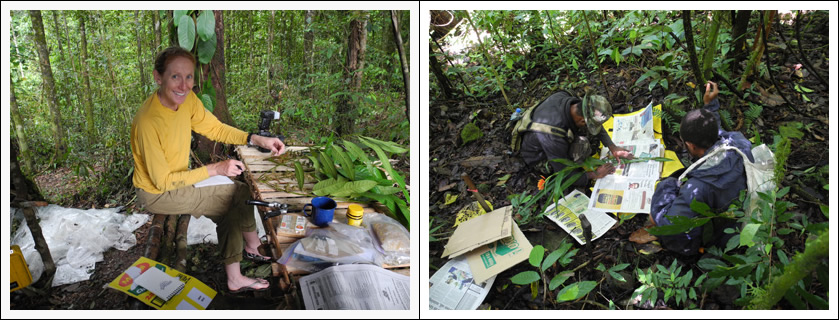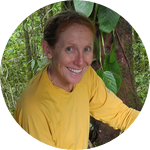About This Project
The Solomon Islands archipelago in the Pacific Ocean has an estimated plant diversity of 4500 species, the same diversity as Texas, but on only 4% of the land area. Intensive biodiversity surveys are urgently needed in this remote location as many new species await discovery. This project will rapidly assess the flora of the highest peaks of Guadalcanal and develop conservation plans to protect against deforestation and invasion of non-native species threatening this unique floral biodiversity.
Ask the Scientists
Join The DiscussionWhat is the context of this research?
Few botanical specimens have been collected from the upper elevations of Guadalcanal. For example, Bishop Museum has only about 800 botanical specimens from the island, and none are from the high, biologically diverse mountain tops. Intensive surveys are expected to result in the discovery of many new species and the documentation of new populations of rare species.
Collecting new specimens will enable scientists and Solomon Islanders to better understand the floral biodiversity and distribution of plants on Guadalcanal in order to develop conservation plans for the region. I have been developing an up-to-date species list of the flora of the Solomon Islands, and new botanical surveys will help validate this already gathered data.
What is the significance of this project?
The rainforests of the Solomon Islands are listed on the World Wildlife Fund's (WWF) Terrestrial Ecoregions of conservation priority. The flora and fauna of the archipelago are considered to be vulnerable due to the clearing of forest for tropical timber, large-scale agricultural plantations and subsistence gardening, largely as a result of population growth. The native forest is also increasingly threatened by non-native species that invade the diverse native forests.
Climate change is expected to influence the diversity of the region, but a baseline measure of the flora in the mountains is needed to gauge these effects into the future. Collections made will also provide needed specimens for other botanical researchers around the world unable to travel to this remote region.
What are the goals of the project?
Working with a team of scientists from around the globe, and with your support, I will survey the intact forest of the high-elevation interior of Guadalcanal for ca. 20 days in September, 2015. Each flowering and fruiting plant specimen will be photographed and collected to document the diversity of species in each area surveyed. Pieces of tissue will also be sampled and preserved for molecular research projects. Specimens resulting from this expedition (>1,000 specimens) will significantly enhance the understanding of the floral biodiversity of Guadalcanal. The distribution and density of endangered, rare and threatened species, and invasive species will be documented. The project will also involve the training of at least one Solomon Islander in biodiversity assessments.
Budget
We are seeking your help for these resources!
Transportation Flying is the only efficient way to get to the Solomon Islands (ca. $1500), and helicopter transfer into the highlands of Guadalcanal ($2500 per hour!) is essential. There are very few roads into the highlands of Guadalcanal (take a look on Google Maps!), and travel by foot with field supplies is time consuming and difficult. Without this helicopter support, survey activities will be restricted to easily accessible areas, reducing the effectiveness of collecting and discovery of both native and invasive species.
Herbarium supplies. It costs approximately $1 per specimen to permanently preserve it for placement in Museum collections. We are seeking your support to help us preserve the collected specimens in perpetuity.
Field food and supplies. Camp food is basic - rice, tinned meat, and hopefully some locally-grown greens! Please help support the purchase of food for field helpers.
Meet the Team
Team Bio
During my career, I have spent many long hours collecting and processing plant specimens by day, and camped in a tent by night, in tropical wilderness. My research interests focus on the diversity and biogeography, or distribution, of flora of the Pacific, by undertaking fieldwork, digitizing botanical collections, and molecular research. For the past 5 years, I have been fortunate to participate in botanical fieldwork in Papua New Guinea, travelling to previously under-surveyed regions, and documenting the flora. During the 10 expeditions in PNG, more than 2,800 new collections were made, with duplicates specimens distributed to more than 32 national and international institutions, and more than 18,000 images of the vascular plants and life in camp were captured. My field collections have resulted in the discovery of 14 range expansions and at least ten new plant species await description. I have been developing a checklist of the flora of the Melanesian region, including the Solomon Islands, and this project will provide new data for the checklist, as well as enhancing the documentation of the distribution of species in the Solomon Islands.
Press and Media
"Bishop Museum Botanist Finds Undiscovered Plants in Papua New Guinea" Honolulu Magazine
See the Papuan plants website for more information about my research!
Additional Information
Where is the research taking place? The Solomon Islands form an archipelago in the Pacific Ocean to the east of Papua New Guinea and to the northwest of Vanuatu, and is part of the region known as Melanesia. Fieldwork will take place on the island of Guadalcanal, in the still intact forested areas at the headwaters of the Ngalimbiu and Tina Rivers on the north coast, and the Itina and Koloula Rivers on the south coast. More specifically, the project will be undertaken in Haiacha and Pukarauvaghalo, which encompasses the high-elevation interior of Guadalcanal, including Mt Popomanaseu and Mt Makarakomburu, the two highest mountains in the Solomon Islands.

What is collected? Each plant specimen collected in the field has flowers or fruits (or both), or has spores if it is a fern. This enables scientists to identify accurately the species. Data, such as a GPS co-ordinate, what the plant looks like and colors, and associated species, are written in waterproof notebooks. Many digital images of the fresh plant are taken, and pieces of leaf tissue are dried in silica gel for future molecular analysis. At least three specimen of each plant species are placed between newspaper, then interleaved with cardboard, and cinched down tightly between wooden frames. These are dried, and become herbarium specimens - a piece of evidence as to the existence of a species at a location at a point in time - to be housed in herbaria for researchers to study now and into the future.

Passing along knowledge. I work closely with in-country researchers, and pass on my knowledge of their flora and scientific best practices. We employ local field assistants to help with field projects, and I am humbled by their knowledge of their rainforests.
Who else is involved? This research is a small component of a larger project to document the biodiversity of Guadalcanal and empower the local Solomon Islands communities to protect and manage their ecosystems. Institutional partners include Solomon Islands National Herbarium (BSIP), Honiara, University of South Pacific, Suva; American Museum of Natural History, New York; Field Museum, Chicago; and Museum of New Zealand Te Papa Tongarewa, Wellington.
Bishop Museum is a non-profit 501c3 organization. If you wish to receive a tax acknowledgment letter in exchange for your contribution, please contact Bishop Museum's Development Office at (808) 847-8281 or development@bishopmuseum.org.
Project Backers
- 24Backers
- 101%Funded
- $5,051Total Donations
- $210.46Average Donation
